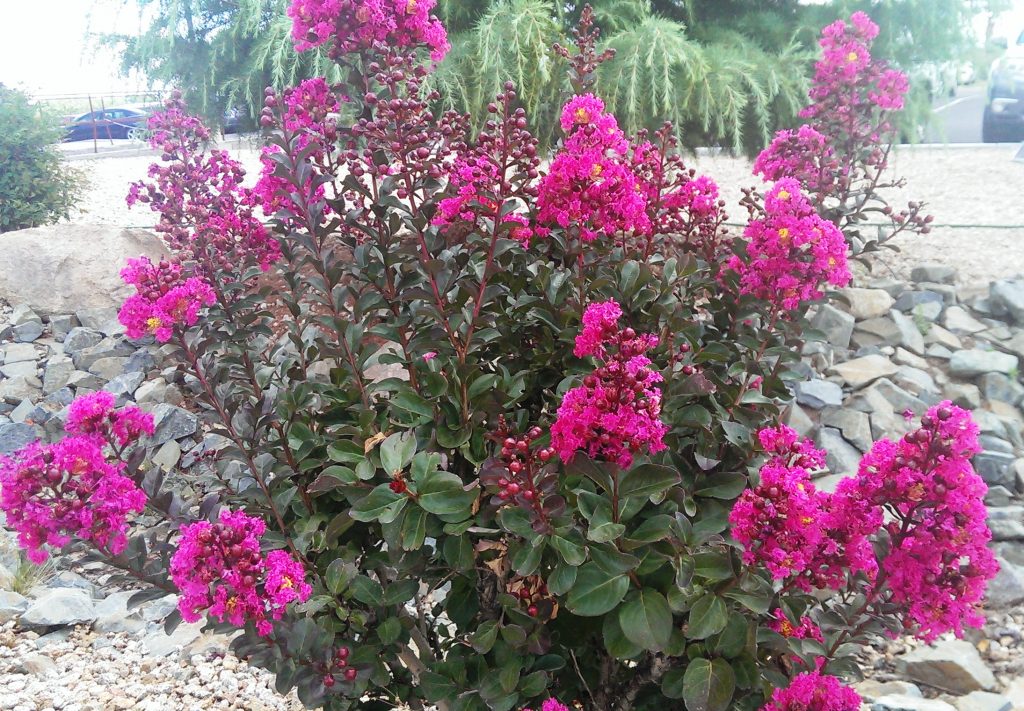by Ken Lain, the mountain gardener
Intense watermelon-pink, solar reds, and LED whites cover this heat-loving bloomer during the late-summer lull in the garden. Use as an accent or to cover unattractive views on a small scale. Plant where you can enjoy its beautiful multicolored bark and sinuous branches up close. The flowers show against forest green foliage that turns red and orange in autumn. Growing to just head height, every yard has room for at least one, and only available for summer planting.

Botanical Name – Lagerstroemia
The Latin name of crape myrtle is Lagerstroemia. Although initially from Asia, Lagerstroemia naturalizes easily in the Southwest and South. Crape myrtles are deciduous shrubs or small trees.
USDA Plant Hardiness Zones
Cold-hardy to planting zone 6, even colder in sunny garden spots. Their growth is restrained by the colder climate, keeping them in shrub form. Rarely do you witness a tree form in the mountain west.
This showy bush often puts on its best flowers during unusually hot summers. Higher elevation gardens are more chilled by nighttime air show less flower and more foliage. Sub-zero winters cause the plant to hibernate underground for the winter.
Plant Description
Natchez crape myrtles grow as large shrubs the easily grow above head height. The foliage becomes a reddish-orange in fall. They have a reddish-brown bark that peels the way birch trees do, giving you winter interest. These trees bear white blooms.
As with most crape myrtles, the flowers are the main selling point. They grow in striking clusters and put on a display that lasts longer than other blooming shrubs, mid-summer through autumn. As a bonus, butterflies are attracted to the flowers. The blooms yield to fruits that are brownish and persist through winter.
Sun and Soil Needs
Crape Myrtle prefers blistering hot full sun and well-drained soil. Exposure to the full sun is an easy way to prevent mildew.
Soil pH should be on the acidic side ranging from 5.0 to 6.5. Use Watters Premium Mulch to increase soil drainage and lower the pH of the soil.
Crape myrtle makes beautiful specimen plants. Used in groups, they form decorative border plantings or privacy hedges. They are often used as street plantings because they don’t mind asphalt heat or confined planting spaces. This is also perfect for planting between boulders in rock soils.
Names Varieties of Crape Myrtle
Many cultivars of crape myrtles have been developed for faster growth, more prolonged bloom, and increased cold hardiness.
- Bicolor (pink – dwarf form, 3 feet)
- Cherokee (red – 8 feet)
- Acoma (white – 12 feet)
- Seminole (pink – 15 feet)
- Tuscarora (coral pink – 20 feet)
- Choctaw (pink – 25 feet)
Distinct from all of these is the parent of Natchez, Lagerstroemia fauriei. A 10-foot shrub grows in zones 6 to 9, this variety stands out from the rest with fragrant flowers. Excellent powdery mildew resistance.
Disease and Pruning
Pruning out branches that cross over other branches promotes airflow and reduces diseases.
Aphids can be drawn to crape myrtles, but easily controlled with Watter Multi-Purpose Insect Spray. Look for ‘Honeydew drops’ from aphids making leaves, and the ground around the plant looks glossy and wet.
Most varieties only need pruning to thin or open up the plant. The best time to prune is January through March since this shrub blooms on new wood.
Remove spent flower heads, or deadhead, throughout summer to extend the bloom cycle. Remove suckers as they appear.

